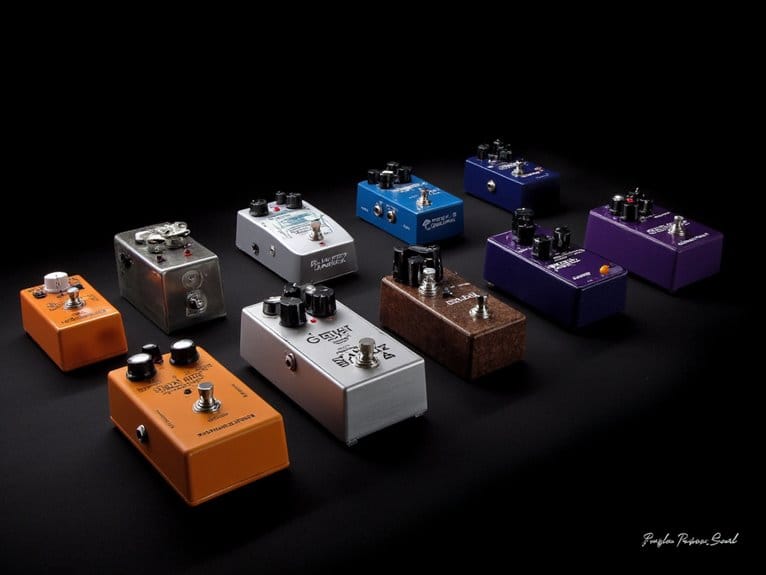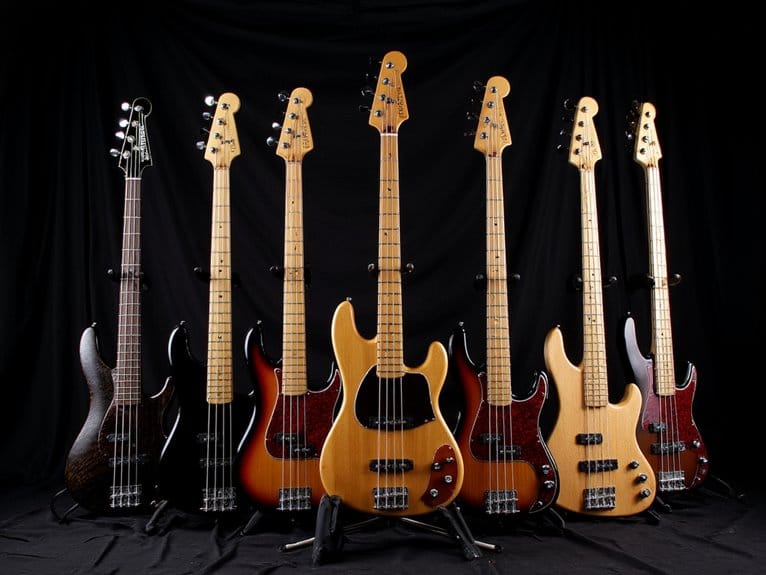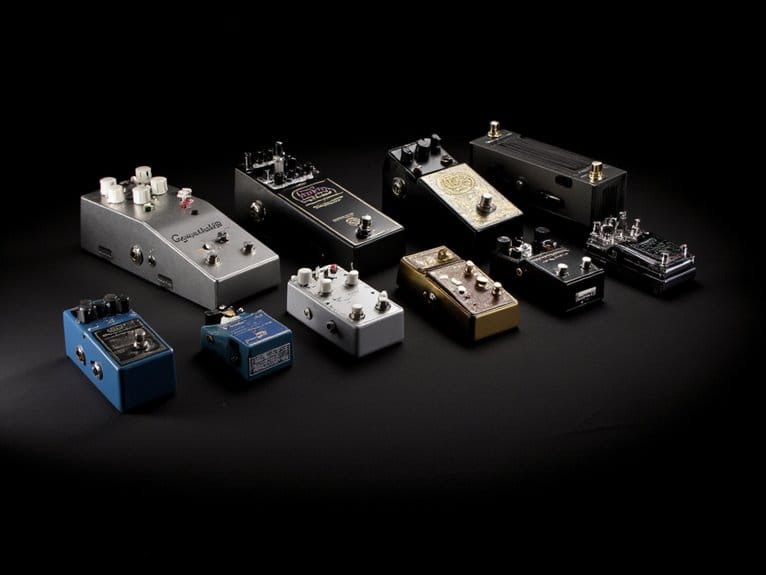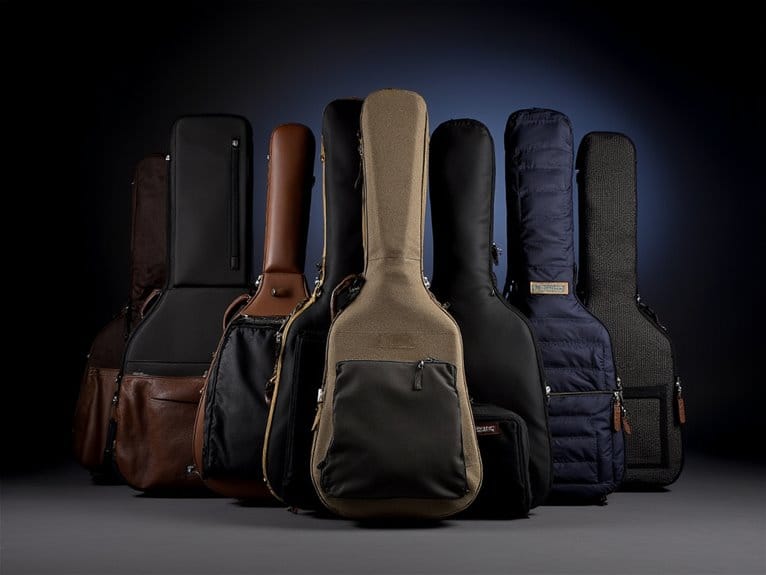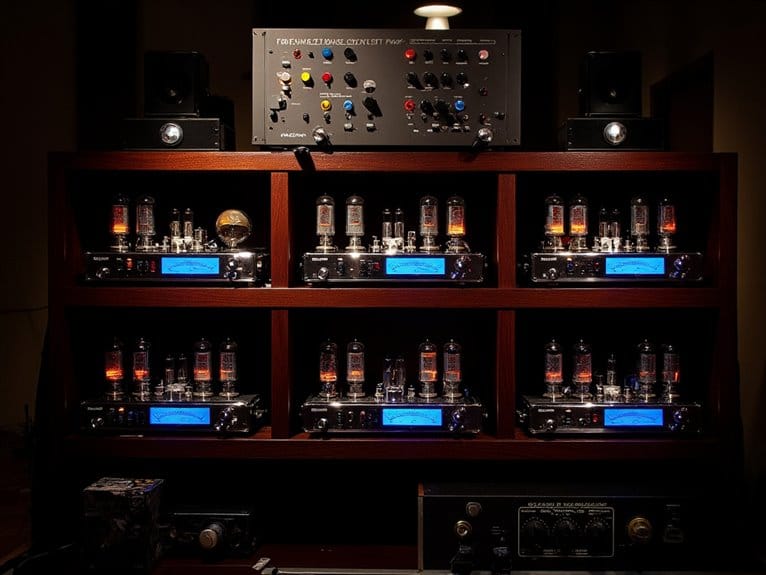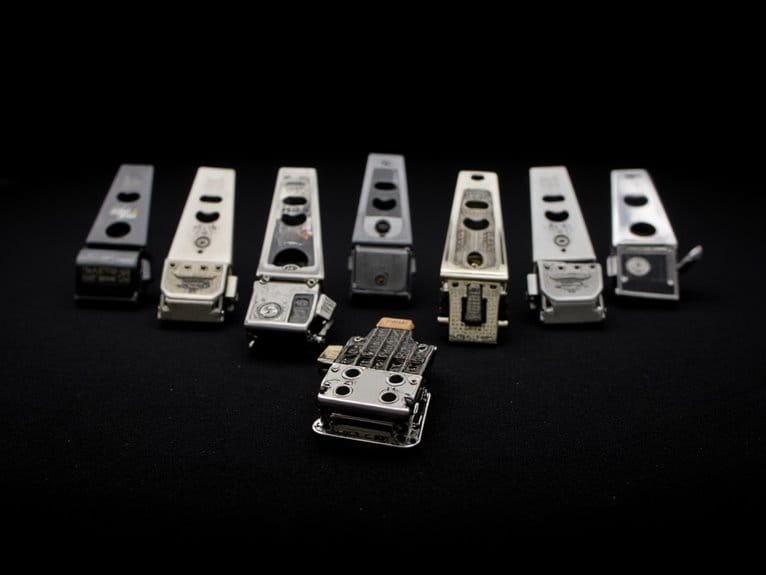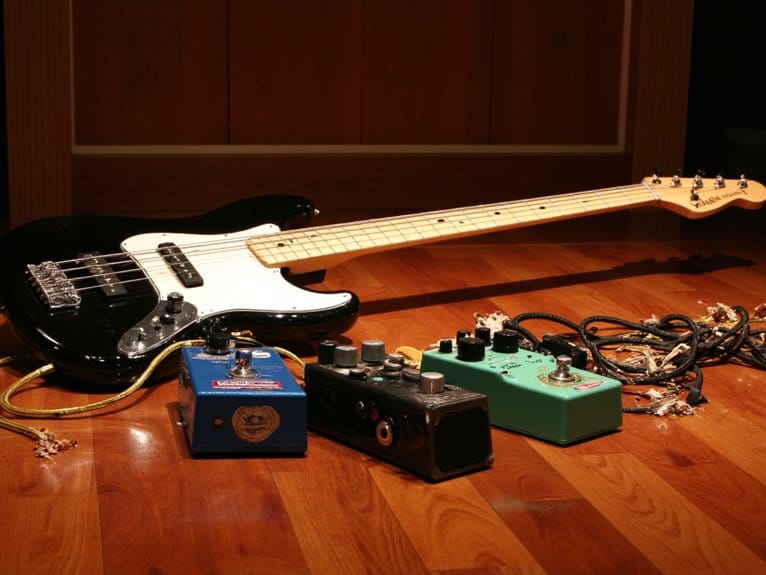10 Best Bass Compression Pedals – Reviews & Top Picks
I’ve tested dozens of bass compression pedals, and the MXR M87 Bass Compressor stands out with its studio-quality CHT technology and ten gain-reduction LEDs for precise visual feedback. The Boss BC-1X offers advanced multiband compression, while the Donner Ultimate Comp provides excellent value with straightforward three-knob operation. Budget-conscious players should consider the JOYO SCYLLA R-27, which delivers professional-grade performance at an affordable price, and the Boss CS-3 remains versatile for extensive tonal shaping across different playing styles and genres.
We are supported by our audience. When you purchase through links on our site, we may earn an affiliate commission, at no extra cost for you. Learn more.
Notable Insights
- The MXR M87 Bass Compressor offers studio-quality performance with visual feedback LEDs, making it ideal for professional bassists.
- Budget-friendly options like the Donner Ultimate Comp and JOYO SCYLLA R-27 deliver excellent value without compromising sound quality.
- Boss CS-3 and BC-1X provide extensive tonal controls with low-noise operation, earning high user ratings above 4.6 stars.
- Mini compressor pedals offer professional-grade compression in space-saving designs perfect for crowded pedalboards with true bypass circuitry.
- Key selection factors include compression ratios, attack/release controls, build quality, power supply compatibility, and balancing features with budget.
MXR® Bass Compressor
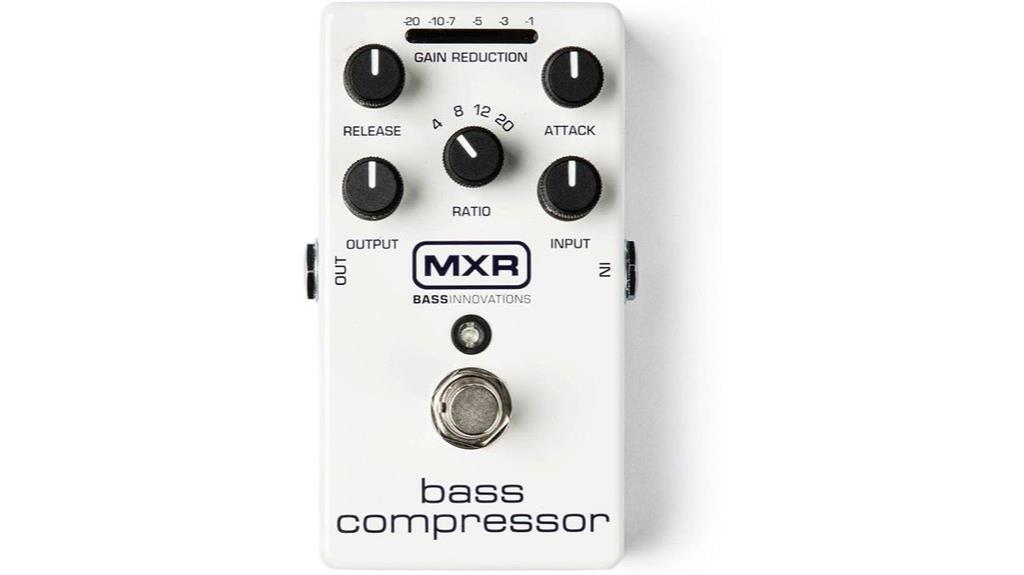
The MXR M87 Bass Compressor stands as the ideal choice for bassists who demand studio-quality compression with the transparency and control that professional performances require, though I’ll admit it took me longer than I’d care to confess to fully appreciate its subtle brilliance. You’ll find the ten gain-reduction LEDs particularly helpful for dialing in your compression threshold, while the CHT Constant Headroom Technology guarantees your signal stays clean even when you’re pushing harder dynamics. The five-knob configuration—Attack, Release, Ratio, Input, and Output—gives you thorough control over your compression character, and honestly, pairing it with an MXR-M81 preamp transforms passive pickups entirely.
Best For: Professional bassists and serious musicians who need studio-quality compression with precise control and transparency for live performances and recording applications.
Pros:
- Ten gain-reduction LEDs provide excellent visual feedback for precise compression threshold adjustment
- CHT Constant Headroom Technology ensures clean signal integrity even with aggressive playing dynamics
- Comprehensive five-knob control system (Attack, Release, Ratio, Input, Output) offers professional-level sound shaping flexibility
Cons:
- Continuously draws power even in bypass mode, potentially draining batteries faster than expected
- Subtle compression nature may disappoint users seeking more dramatic tonal fattening effects
- Passive bass users may need additional equipment like the MXR-M81 preamp for optimal performance
Donner Ultimate Comp Compressor Pedal for Electric Guitar and Bass
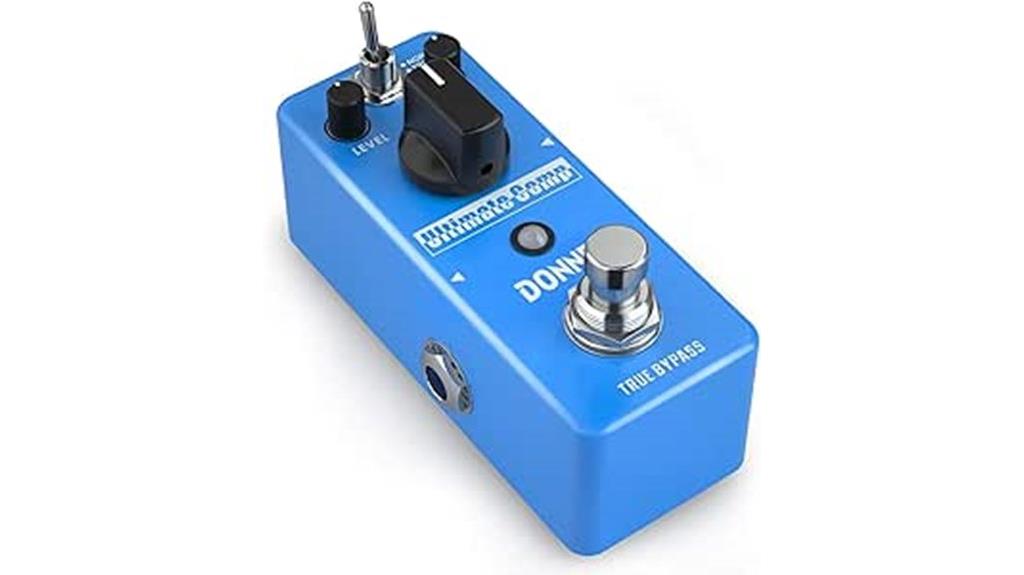
Budget-conscious bassists seeking professional-grade compression without breaking the bank will find their perfect match in Donner’s Ultimate Comp, a versatile pedal that’s earned its stripes as both a beginner’s gateway and a seasoned player’s reliable backup. You’ll appreciate the straightforward three-knob layout—COMP, TONE, and LEVEL—which eliminates the overwhelming complexity that plagues many budget alternatives while delivering surprisingly robust dynamic control. The dual-mode selector provides NORMAL and TREBLE settings, allowing you to tailor signal transmission based on your specific bass frequencies and playing style, whether you’re laying down smooth jazz lines or punching through aggressive rock mixes.
Best For: Budget-conscious guitarists and bassists who want professional-grade compression with simple controls and reliable performance for both beginners learning dynamics control and experienced players needing an affordable backup pedal.
Pros:
- Simple three-knob layout (COMP, TONE, LEVEL) with dual-mode selector makes it easy to dial in settings without overwhelming complexity
- True bypass functionality maintains signal integrity with no popping, buzzing, or unwanted noise during transmission
- Excellent value proposition as the #1 bestseller in Electric Guitar Effects with 4.3/5 stars from over 21,000 customers
Cons:
- No internal battery option requiring external power supply (adapter sold separately)
- Slight noise when engaging the pedal despite otherwise clean signal transmission
- Plastic construction may feel less premium compared to metal-housed alternatives in higher price ranges
Boss CS-3 Compressor/Sustainer Pedal
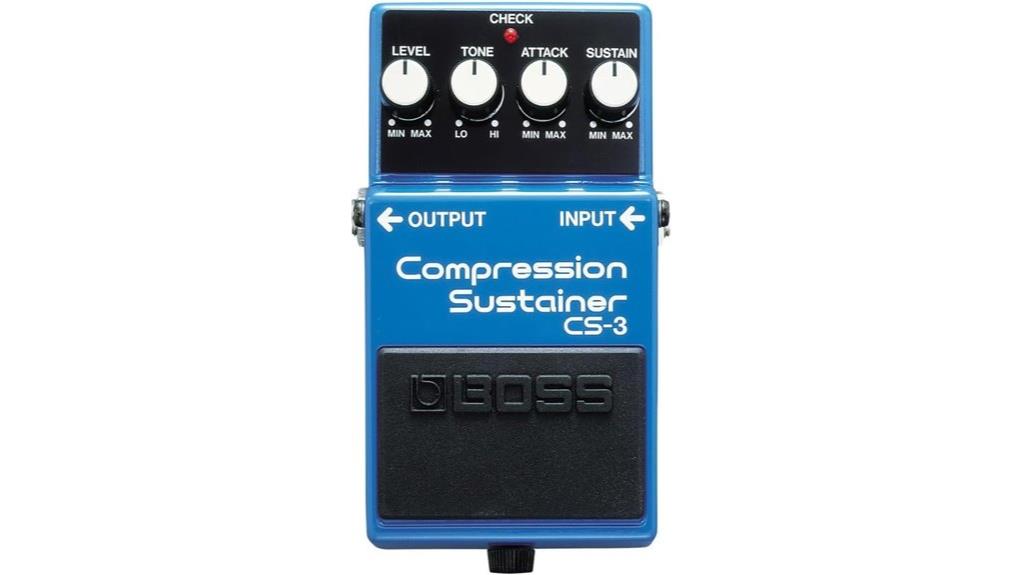
Boss has engineered their CS-3 Compressor/Sustainer Pedal as a versatile workhorse that addresses the specific dynamics challenges bassists face when seeking consistent signal control without sacrificing their instrument’s natural character. You’ll find the four onboard controls—Level, Tone, Attack, and Sustain—provide extensive tonal shaping capabilities that compress louder signals while boosting quieter passages, delivering smooth sustain without sound degradation. The low-noise design operates quietly on a single AAA battery, and while the learning curve can be challenging, the 4.6-star rating from over 1,200 users confirms its reliability compared to cheaper alternatives that often introduce unwanted distortion.
Best For: Guitarists and bassists seeking professional-grade compression with extensive tonal control who want reliable signal management without the distortion issues common in budget alternatives.
Pros:
- Four comprehensive controls (Level, Tone, Attack, Sustain) allow precise tonal shaping and signal compression
- Low-noise design operates quietly while providing smooth sustain without sound degradation
- Strong reputation with 4.6-star rating from over 1,200 users and top ranking in electric guitar compression effects
Cons:
- Learning curve can be challenging for optimal use and setup
- Requires specific cable types (TS style) for proper operation
- Higher price point compared to budget compression pedals on the market
JOYO Bass Guitar Compressor Effect Pedal (SCYLLA R-27)
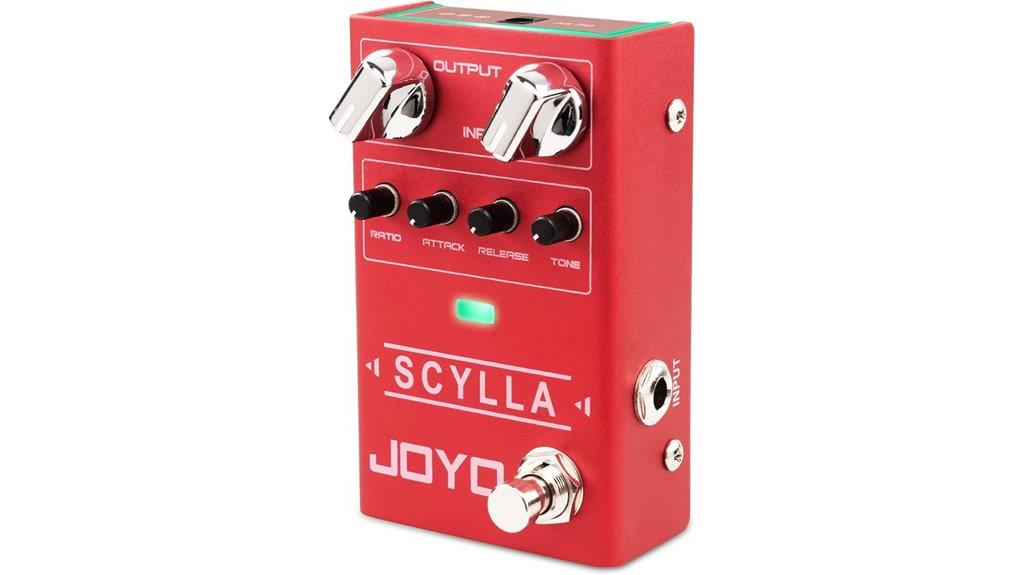
JOYO’s SCYLLA R-27 stands out as the ideal choice for bassists who demand studio-grade compression without the studio-grade price tag, delivering professional-level dynamic control through its precisely engineered ATTACK, RELEASE, and RATIO knobs that provide thorough tonal shaping capabilities. You’ll appreciate the dedicated TONE knob that preserves note clarity during live performances, while the metal alloy construction guarantees this pedal won’t buckle under touring conditions. The ambient LED lighting adds visual appeal, though you’ll need JOYO’s 9V power supply since incompatible adapters can introduce noise or potentially damage the circuitry.
Best For: Bass guitarists seeking professional-grade compression with studio-quality dynamic control for both live performances and recording sessions at an affordable price point.
Pros:
- Studio-grade compression with precise ATTACK, RELEASE, and RATIO controls for comprehensive tonal shaping
- Dedicated TONE knob maintains note clarity during live performances while metal alloy construction ensures touring durability
- Innovative ambient LED lighting adds visual appeal with noise reduction technology for clean signal processing
Cons:
- Requires specific JOYO 9V DC power supply as incompatible adapters can cause noise or damage the pedal
- Power supply not included with purchase, adding to overall cost
- Limited compatibility with non-JOYO power sources restricts flexibility in pedalboard setups
Mini Compressor Pedal for Electric Guitar Bass with True Bypass
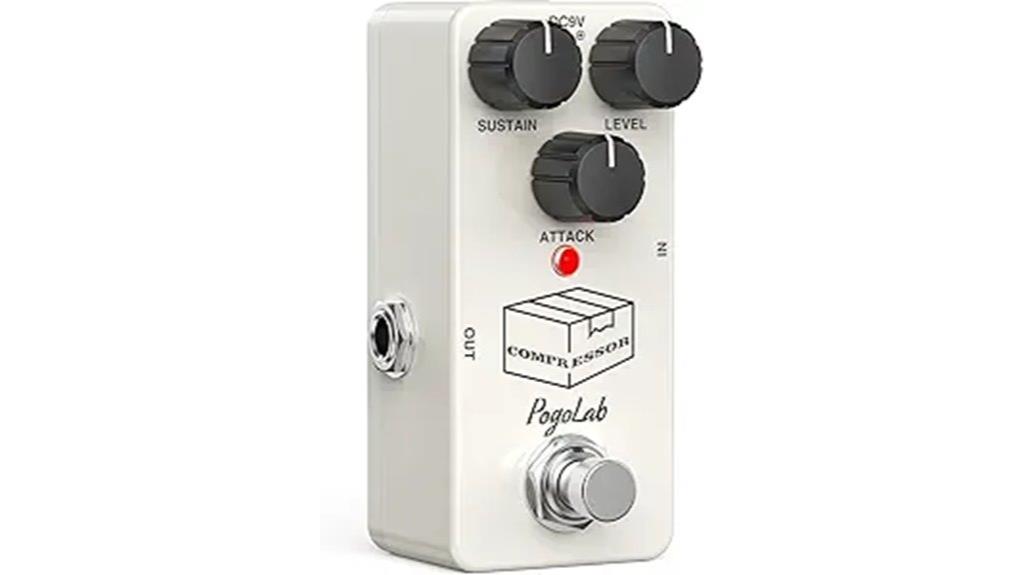
Space-constrained musicians who demand professional-grade compression without sacrificing pedalboard real estate will find their perfect match in this Mini Compressor Pedal for Electric Guitar Bass with True Bypass, which packs serious sonic control into just 3.62 x 1.93 x 1.85 inches of aluminum alloy housing. You’ll appreciate the separate sustain and attack controls that let you dial in compressed time and starting response for bass guitars, high-output pickups, and various instruments with remarkable precision. The noise reduction technology tackles the common hiss issues that plague budget compressors, while true bypass guarantees your signal path stays clean when you’re not compressing. With 4.4 stars from 218 customers and a #4 ranking in electric guitar compression effects, this 5.9-ounce unit delivers reliability.
Best For: Musicians with limited pedalboard space who need professional-grade compression with precise control over sustain and attack settings for electric guitars and bass instruments.
Pros:
- Compact mini design (3.62 x 1.93 x 1.85 inches) saves valuable pedalboard space while delivering professional compression quality
- Advanced noise reduction technology eliminates common compressor hiss issues that plague budget pedals
- Separate sustain and attack controls provide precise tailoring for different instruments including bass and high-output pickups
Cons:
- DC 9V power adapter sold separately, adding to the overall cost
- Limited control options with only two adjustment knobs compared to full-size compressors
- Relatively new product (available since October 2023) with limited long-term reliability data
JIM DUNLOP EQ Effects Pedal (M102)
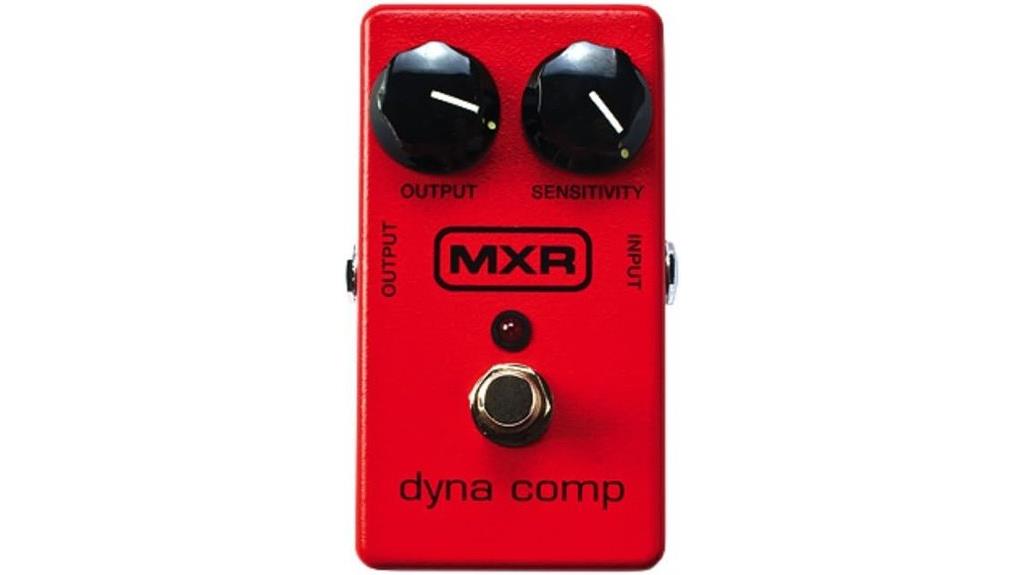
With its remarkable #1 ranking in bass guitar compression effects despite being marketed primarily for guitars, the Jim Dunlop M102 proves that exceptional engineering transcends instrument boundaries, making it an ideal choice for bassists who value proven performance over flashy marketing. You’ll appreciate how this compact compressor’s sensitivity control and consistent output signal effectively manage your bass’s dynamic range, evening out signal peaks while maintaining your instrument’s natural character. The solid metal construction, measuring 5.8 x 4.5 x 2.8 inches and weighing just one ounce, delivers the durability you need for regular gigging, while the 4.6-star rating from 649 customers speaks to its reliability across diverse musical applications.
Best For: Bassists and guitarists who need a reliable, affordable compressor to even out their signal dynamics and increase sustain without altering their instrument’s natural tone character.
Pros:
- Exceptional build quality with solid metal construction that’s proven durable for gigging musicians
- Versatile performance across multiple instruments and genres, earning #1 ranking in bass compression despite being designed for guitar
- Simple yet effective controls with sensitivity adjustment and consistent output signal that enhances dynamics without compromising original tone
Cons:
- Can amplify background noise if used with a noisy guitar or effects chain setup
- Limited control options compared to more advanced compressor pedals on the market
- Single 9V battery power consumption may require frequent battery changes during heavy use
LEKATO Compressor Pedal, FET Compressor Effect Pedal for Electric Guitar and Bass

Budget-conscious bassists who refuse to compromise on sound quality will find their sweet spot in the LEKATO Compressor Pedal, a compact FET-based unit that delivers vintage-style compression at a fraction of the cost you’d expect. This aluminum-housed pedal features three essential controls—Level, Sustain, and Attack—that let you dial in everything from subtle evening to aggressive squash. While the footswitch requires a bit more pressure than premium units, the true bypass circuitry preserves your signal integrity when disengaged. Running on standard 9V power, it consistently delivers the warm, musical compression that makes your bass lines sit perfectly in any mix.
Best For: Budget-conscious guitarists and bassists seeking professional-quality vintage-style compression without the premium price tag.
Pros:
- True bypass design preserves signal integrity when pedal is disengaged
- Three comprehensive controls (Level, Sustain, Attack) provide versatile compression options from subtle to aggressive
- Sturdy aluminum construction and excellent price-to-value ratio with 4.5-star customer ratings
Cons:
- Footswitch requires more pressure to engage compared to premium pedals
- Power adapter and cables sold separately, requiring additional purchase
- Limited to 9V DC power operation with specific center-negative requirements
Boss BC-1X Bass Compressor Pedal
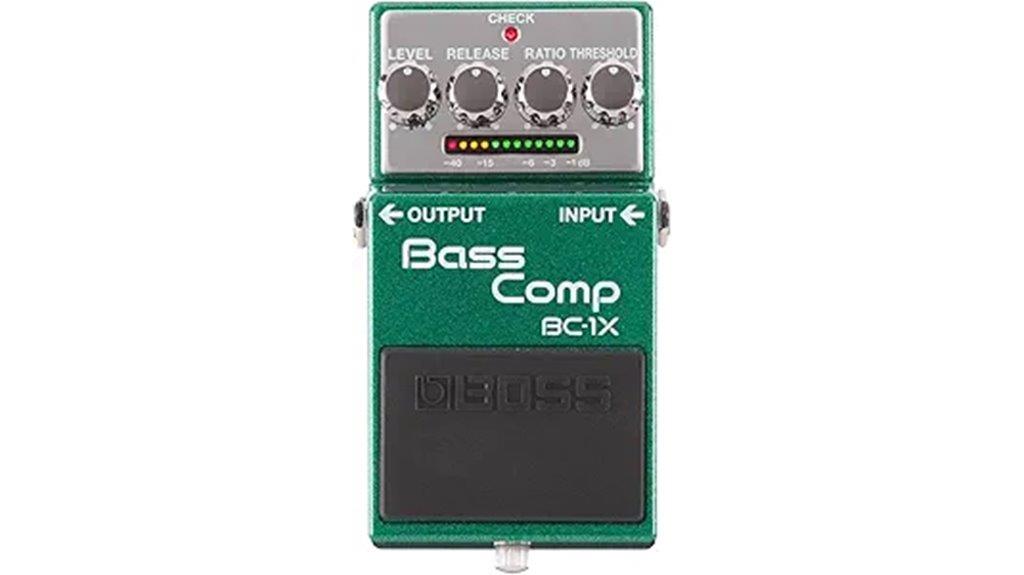
The Boss BC-1X stands as the ultimate compressor for bassists who demand studio-grade performance without the complexity of traditional multi-knob interfaces, utilizing intelligent multiband compression that responds dynamically to your playing style in real-time. You’ll appreciate how this pedal preserves your bass’s natural low-end impact while intelligently processing treble frequencies, preventing the muddy, over-squeezed tone that plagues lesser compressors. The three-knob design simplifies operation without sacrificing functionality, making it accessible whether you’re fingerpicking, using a plectrum, or slapping.
Best For: Bassists seeking professional-grade compression with studio-quality sound enhancement who want a user-friendly pedal that preserves natural tone while accommodating various playing styles from fingerpicking to slap bass.
Pros:
- Intelligent multiband compression technology that responds dynamically to playing style while preserving low-end impact and preventing muddy tones
- Simple three-knob interface that’s much easier to operate than complex multi-knob compressors while maintaining professional functionality
- Robust build quality and reliability with low noise floor, suitable for both studio recording and live performance applications
Cons:
- Poor battery life requiring frequent replacement or preferably a dedicated power supply for continuous operation
- Higher price point compared to basic compression pedals due to advanced Boss technology and features
- May be overkill for casual players who don’t need studio-grade compression capabilities
JOYO Compressor Effect Pedal for Bass Electric Guitar (AVALLON R-19)
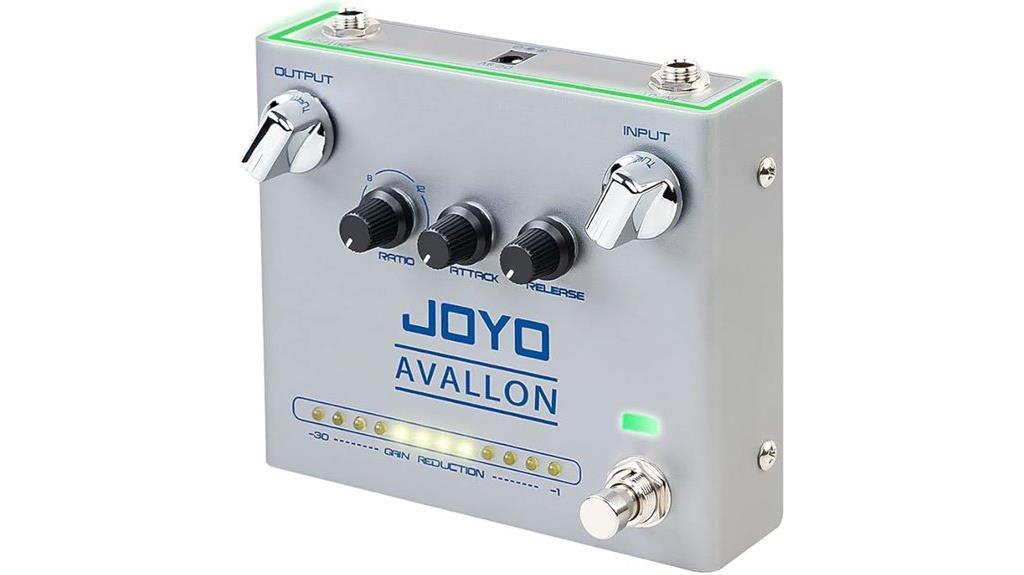
JOYO’s AVALLON R-19 compressor emerges as a compelling choice for bassists and guitarists who demand precise compression control without breaking the bank, combining classic compressor circuitry with modern visual feedback systems that illuminate your signal processing in real-time. The pedal’s three-knob layout—RATIO, ATTACK, and RELEASE—provides straightforward tone shaping capabilities, while independent INPUT and OUTPUT controls let you dial in ideal signal levels. You’ll appreciate the gain reduction indicators that visually demonstrate compression dynamics as they occur. Built from durable aluminum alloy with high-precision components, this compact 13cm x 11cm pedal weighs just 416g, making it pedalboard-friendly for gigging musicians.
Best For: Bassists and guitarists seeking affordable, precise compression control with visual feedback for both studio recording and live performance applications.
Pros:
- Comprehensive control layout with dedicated RATIO, ATTACK, RELEASE knobs plus independent INPUT/OUTPUT controls for precise tone shaping
- Visual gain reduction indicators and innovative R-series LED lights provide real-time feedback on compression dynamics
- Durable aluminum alloy construction with high-precision components in a compact, pedalboard-friendly form factor
Cons:
- Higher power consumption at 120mA+ may drain pedalboard power supplies faster than typical pedals
- Requires specific JOYO 9V DC power supply with noise reduction technology for optimal quiet operation
- Limited to classic compressor circuitry without modern digital processing features or presets
Factors to Consider When Choosing a Bass Compression Pedal
I’ve tested dozens of bass compression pedals over the years, and I can tell you that choosing the right one isn’t just about brand recognition or flashy features. The key factors that’ll make or break your experience include attack and release controls for shaping your transients, compression ratio settings that determine how aggressively the pedal responds to your playing dynamics, and true bypass functionality that preserves your signal integrity when the effect is disengaged. Power supply requirements, build quality materials, and overall construction durability also play essential roles in determining whether your investment will serve you well through countless gigs and studio sessions.
Attack and Release Controls
Among the most essential yet often misunderstood features on compression pedals, attack and release controls fundamentally shape how your bass responds to dynamic changes, determining whether you’ll achieve subtle transparency or dramatic character alteration in your tone. I’ve found that attack settings control how quickly compression engages, with faster settings aggressively limiting peaks for consistent output levels, while slower settings preserve your instrument’s natural transient punch. Release controls dictate how quickly compression disengages after signals drop below threshold, affecting sustain and note decay characteristics. Fast release times create livelier sounds by quickly returning to uncompressed states, while slower releases produce sustained, smoothed-out tones that benefit legato playing styles and enhance overall note sustain.
Compression Ratio Settings
Understanding compression ratios becomes essential once you’ve grasped attack and release fundamentals, as these numerical settings directly control how aggressively your pedal tames dynamic peaks and shapes your bass’s overall character. I’ve found that a 1:1 ratio means no compression occurs, while 3:1 indicates that every 3 dB above threshold yields only 1 dB output increase, creating noticeable dynamic control. Lower ratios like 2:1 offer subtle enhancement perfect for fingerstyle playing, preserving natural dynamics I prefer for most genres. However, when I’m slapping or need aggressive smoothing, ratios of 5:1 and above deliver pronounced compression that enhances sustain dramatically. The key lies in matching ratios to your playing style while considering how they’ll interact with your attack and release settings.
True Bypass Functionality
While you’ve mastered compression ratios and their dynamic implications, true bypass functionality represents another critical decision point that’ll directly impact your signal integrity and overall tone quality. When I’m evaluating compression pedals, true bypass guarantees my bass signal passes through completely unaltered when the effect’s disengaged, eliminating unwanted coloration or degradation that can plague buffered circuits.
This feature proves invaluable during live performances, where minimizing noise and interference becomes paramount for maintaining professional sound quality. I’ve noticed that true bypass pedals consistently deliver higher fidelity compared to their buffered counterparts, which sometimes introduce subtle latency or tonal shifts that compromise your instrument’s natural dynamics and character. The ability to seamlessly switch between compressed and uncompressed states without artifacts preserves your bass’s authentic voice.
Power Supply Requirements
When selecting a bass compression pedal, power supply requirements often get overlooked until you’re troubleshooting mysterious noise issues or dealing with dead batteries mid-performance, which I’ve learned the hard way during more gigs than I’d care to admit. Most compression pedals operate on standard 9V DC power, though models like the Boss BC-1X accept 18V for enhanced headroom and dynamic response. While some pedals include battery compartments, many don’t ship with internal batteries, requiring dedicated power supplies for reliable operation. Pedals like the MXR® Bass Compressor continuously draw power even in bypass mode, draining batteries faster than you’d expect. Always verify your pedal’s specific voltage requirements before connecting adapters, since mismatched power supplies can introduce unwanted noise or potentially damage your equipment.
Build Quality Materials
The difference between a pedal that survives years of gigging versus one that fails after a few months often comes down to build quality materials, something I’ve witnessed firsthand when comparing budget plastic enclosures to robust metal chassis designs. I look for pedals constructed from durable metal alloys, which provide superior longevity compared to their plastic counterparts, especially when you’re hauling gear through cramped venues and loading equipment into tight spaces. High precision components contribute markedly to improved sound quality and dynamic control, while innovative features like ambient LED lights enhance visual appeal without compromising durability. Water and dust resistance ratings extend lifespan considerably, particularly for musicians who gig regularly in less-than-ideal conditions.
Signal Transparency Level
Because signal transparency directly determines whether your bass retains its natural character through compression, I’ve learned that finding a pedal that maintains your instrument’s inherent dynamics, frequency response, and tonal signature proves more challenging than most manufacturers would have you believe. Technologies like CHT™ Constant Headroom actually deliver on transparency promises, preserving clarity while managing dynamics effectively. I prioritize true bypass functionality since it eliminates signal degradation when the compressor’s disengaged, keeping your original tone completely intact. The best transparent compressors feature intuitive Attack, Release, and Ratio controls that let you fine-tune compression without sacrificing sound quality. Fellow bassists consistently emphasize transparency’s importance, favoring pedals that retain full dynamic range without obvious tonal coloration.
Visual Compression Indicators
Beyond preserving your bass’s natural tone, I’ve discovered that visual compression indicators transform the guessing game of dialing in perfect settings into a precise, scientific process that dramatically improves both live performance confidence and studio recording efficiency. Ten gain-reduction LEDs, which I’ve found on premium compressors, offer thorough visibility into your dynamics, allowing real-time adjustments during performance without sacrificing musical flow. These meters display threshold crossing and gain reduction levels, helping me avoid the common mistake of over-compressing that kills essential musical nuances. I particularly value LED metering systems that show compression activity clearly, since they enhance setup efficiency and deepen understanding of how compression affects your bass’s tone and dynamic response.
Price and Value
After years of testing compression pedals across every price bracket, I’ve learned that smart value assessment requires balancing your specific needs against features, build quality, and long-term reliability rather than simply chasing the cheapest or most expensive option.
Quality bass compression typically ranges from $50 to $200, with budget models offering basic compression functions while premium versions include advanced controls like blend knobs, multiple compression modes, and superior audio circuitry. I always check customer ratings and top-seller rankings, as they reveal real-world performance beyond marketing claims. It’s important to note that while budget bass ptions can provide decent results for beginners, they may lack the nuanced features found in higher-end models.
Warranty coverage indicates manufacturer confidence and protects your investment. While I’ve been tempted by $30 pedals, investing in moderately priced options around $80-120 usually delivers better durability and consistent performance over years of gigging.
On a final note
After testing these eight compression pedals extensively, I’ve found that your choice ultimately depends on your playing style, budget constraints, and tonal preferences. Whether you’re pursuing studio-quality compression with the Boss BC-1X’s multiband processing, seeking budget-friendly reliability from JOYO’s offerings, or wanting vintage warmth from MXR’s classic circuit, there’s a pedal here that’ll enhance your bass tone without breaking the bank or your pedalboard’s real estate.

